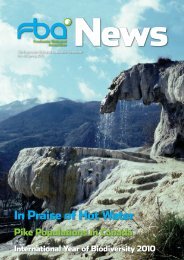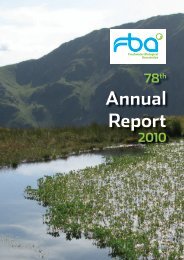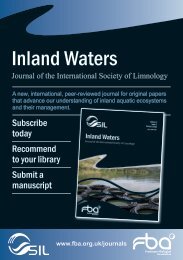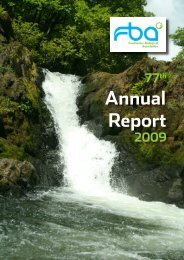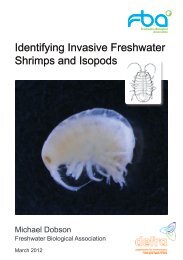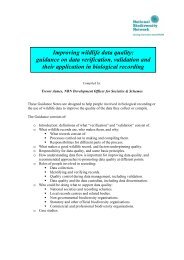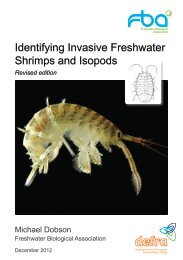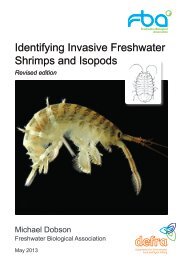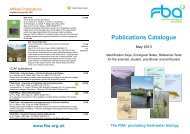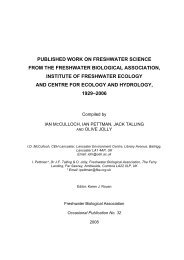The Tyne Pearl Mussel Project - Freshwater Biological Association
The Tyne Pearl Mussel Project - Freshwater Biological Association
The Tyne Pearl Mussel Project - Freshwater Biological Association
Create successful ePaper yourself
Turn your PDF publications into a flip-book with our unique Google optimized e-Paper software.
<strong>The</strong> <strong>Tyne</strong> <strong>Pearl</strong> <strong>Mussel</strong><br />
<strong>Project</strong><br />
Marie-Pierre Gosselin, Louise Lavictoire and Roger<br />
Sweeting<br />
Wednesday 25 January - Rochester Village Hall, Redesdale
<strong>The</strong> <strong>Freshwater</strong> <strong>Biological</strong><br />
<strong>Association</strong> – Introduction<br />
• 2 sites: Windermere and<br />
Dorset<br />
• Identification courses<br />
• Scientific publications<br />
• <strong>Pearl</strong> <strong>Mussel</strong> Ark project<br />
• Captive breeding<br />
programme<br />
• Research on host<br />
specificity of the<br />
freshwater pearl mussel.
<strong>The</strong> <strong>Tyne</strong> <strong>Pearl</strong> <strong>Mussel</strong> <strong>Project</strong><br />
• October 2010 – December 2012<br />
• Based at FBA; funded by FBA, the Environment<br />
Agency and Northumbrian Water.<br />
• Two aims:<br />
1. Identify the factors responsible for the<br />
decline of the freshwater pearl mussel in the<br />
North <strong>Tyne</strong> catchment.<br />
2. Design a robust, evidence-based restoration<br />
plan for the species in the North <strong>Tyne</strong> and<br />
Rede
Introduction-<strong>Freshwater</strong> pearl<br />
mussel ecology and life cycle<br />
. Lives up to 120 years<br />
. Complex, peculiar life cycle<br />
. Parasitic larval stage on<br />
salmonid host
Habitat requirements of the<br />
freshwater pearl mussel<br />
• Well oxygenated water<br />
• Low calcium concentration<br />
• Oligotrophic rivers<br />
• Location of pearl mussel<br />
beds usually downstream<br />
of riffles<br />
• Ideal substrate: mix of fine<br />
gravel with larger cobble<br />
and boulder.<br />
Gail Butterill
<strong>The</strong> North <strong>Tyne</strong> catchment<br />
* Map courtesy of the <strong>Tyne</strong> Rivers Trust
<strong>The</strong> River Rede<br />
• Main tributary of the river North <strong>Tyne</strong><br />
• 58 Km long<br />
• Geology of carboniferous sandstones with shales covered by<br />
clay and peat.<br />
• Regulated by Catcleugh Reservoir in its upper reaches (1905)<br />
with a minimum compensation flow of 0.158 m 3 s -1 at all times.<br />
• Rede = 33% of entire volume of water in North <strong>Tyne</strong><br />
• Water quality status “good” according to Water Framework<br />
Directive<br />
• Variety of fish species: brown trout, Atlantic salmon, eel,<br />
lamprey, bullhead, stone loach.<br />
• Vast salmonid stocking programme: e.g. 2010: 166,791 young<br />
Atlantic salmon stocked in the Rede ONLY (around 0.5fish/m 2 )
<strong>The</strong> River Rede – fish diversity<br />
• Brown trout<br />
• Eel<br />
• Brook lamprey<br />
• Bullhead<br />
• Atlantic salmon<br />
• Stone loach<br />
www.krisweb.com<br />
davekilbeyphotography.co.uk
Land use in the catchment<br />
Land use<br />
North<br />
<strong>Tyne</strong><br />
Grassland 57 82<br />
Forestry/<br />
woodland<br />
37 17<br />
Arable farmland 4 0<br />
Urban 0 0<br />
Water 2 2<br />
Semi-natural 0 0<br />
Rede<br />
Total 100% 100%<br />
Land<br />
ownership<br />
North <strong>Tyne</strong><br />
Private 67 64<br />
MoD 0 20<br />
Forestry<br />
Commission<br />
Northumbrian<br />
Water<br />
30 15<br />
3 1<br />
Rede<br />
Total 100% 100%<br />
58 discharge consents registered<br />
(Environment Agency). Mostly<br />
“secondary treated sewage to river”<br />
and “septic tanks to river”.
Following the Rede...
<strong>The</strong> freshwater pearl mussel in the<br />
North <strong>Tyne</strong> catchment<br />
• Distribution currently limited to the Rede<br />
and the North <strong>Tyne</strong> downstream of its<br />
confluence with the Rede.<br />
• Estimated population: around 50,000<br />
individuals on both rivers (2006 survey)<br />
• Largest beds: Hindhaigh (499) and<br />
Townhead (286) in 2006.<br />
• Most mussels are 50 to 80 years old<br />
and young mussels are rare.<br />
• No apparent recruitment<br />
• Host fish historically believed to be<br />
Atlantic salmon (Salmo salar). No<br />
success from the release of artificially<br />
infected juvenile fish<br />
Kielder<br />
North <strong>Tyne</strong><br />
South <strong>Tyne</strong><br />
River Rede<br />
<strong>Tyne</strong>
So what‟s going wrong?<br />
• Impacted flow regime (Kielder releases)<br />
on the North <strong>Tyne</strong>?<br />
• Changes in land use?<br />
• Pollution?<br />
• Organic enrichment, eutrophication?<br />
• Suspended sediments?<br />
• Siltation and clogging of substrate?<br />
• Host fish density?<br />
• <strong>Pearl</strong> fishing?<br />
• Most mussels are over 80 and young mussels<br />
are rare so it is likely that the factors responsible<br />
for the decline are not recent !
Water Quality Monitoring<br />
• Monthly monitoring by the Environment Agency<br />
- on the North <strong>Tyne</strong> since 1976<br />
- on the Rede since 1990<br />
• Monitoring sites at Cottonshope Foot, Otterburn (1990 to<br />
present) and Redesmouth (1991-2006)<br />
• Parameters recorded included suspended solids, nitrate, ammonia,<br />
dissolved oxygen, orthophosphates, pH and some heavy<br />
metals.<br />
• Problems: - monitoring not frequent enough<br />
- no standardisation on the river and across the<br />
catchment<br />
- no measurements of pesticides levels<br />
- no measurements of suspended sediments, turbidity
Water quality and species<br />
requirements-1<br />
<strong>Biological</strong> Oxygen Demand
Water quality and species<br />
requirements-2<br />
• Suspended solids at Otterburn
Water quality and species<br />
requirements-3<br />
• Nitrate
Water quality and species<br />
requirements-4<br />
• Phosphate
Water quality monitoring July ‟11 –<br />
January „12<br />
• Turbidity
Conclusions from water quality<br />
data analysis<br />
• Enrichment and increase<br />
in fine sediments appear to<br />
be responsible for pearl<br />
mussel decline in the<br />
North <strong>Tyne</strong> and Rede<br />
• Fine sediments from<br />
erosion and runoff<br />
• Enrichment probably as a<br />
result of agriculture and<br />
other human activities.
Causes of sediment input/siltation<br />
• Poaching by livestock<br />
• Dredging of the river<br />
channel<br />
• Topography of the<br />
catchment<br />
• Drainage on arable land<br />
• Forestry activities
Causes of nutrient enrichment in<br />
water<br />
• Agriculture<br />
(fertilizers, drainage,<br />
manure)<br />
• Wastewater<br />
• Untreated sewage
Example of a semi-natural system<br />
www.ecan.govt.nz
Other work and findings<br />
• Host fish preference:<br />
Atlantic salmon/brown trout<br />
• Fieldwork: characterisation<br />
of physical habitat across<br />
the catchment
What we can do to help the pearl<br />
mussel.<br />
HABITAT ACTIONS<br />
• Implement a more comprehensive water<br />
quality monitoring programme<br />
• Limit sediment input in the river<br />
• Prevent nutrient input in the water<br />
• Clean gravels: desilting<br />
PEARL MUSSEL ACTIONS<br />
• Captive breeding programme for adult<br />
relocations<br />
• Release of infected fish in the river
Examples of habitat restoration<br />
Forestry.gov.uk<br />
<strong>Tyne</strong> Rivers Trust<br />
Defra.gov.uk
HE<br />
REDE PEARL<br />
MUSSELS NEED<br />
YOU!!!



